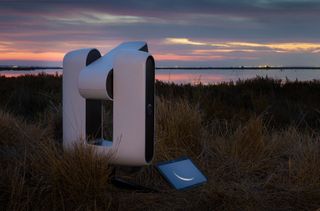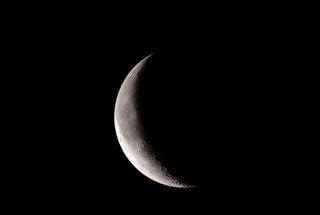Why Does the Stellina Telescope Skip the Eyepiece?

NEW YORK — A sleek, new telescope has us wondering — are eyepieces a thing of the past?
Last night (May 16), amid music and wine, Vaonis, a French telescope startup, presented the shiny features of its premiere scope, called Stellina, to a crowd of astronomers, writers, teachers and enthusiasts at a small gathering in Manhattan. The scope, a backpack-size instrument that is the visual crossroads between Hal of "2001: A Space Odyssey" and Eve from "Wall-E," was admired and inspected by the crowd like a delicate sculpture. The artistic display seemed fitting, as Stellina has been featured by the MoMA Design Store for their "La French Tech au MoMA" event.
The most shocking feature from this telescope seemingly plucked from the pages of a sci-fi screenplay: Stellina has no eyepiece. [Best Telescopes for the Money]
Now, this is certainly not the only scope to be made without an eyepiece, and there is a growing wave of "smart scopes" that favor connectivity and a digital interface over a traditional view. But still, something about this feature, or lack thereof, felt strange.
To peer into the depths of the cosmos with your naked eye seems like a privilege you would never choose to give up. Inspecting the moon's craters and carefully adjusting until you see all four of Jupiter's moons — would the experience be the same through an app?
Cyril Dupuy, the young founder and CEO of Vaonis who developed Stellina, explained the company's choice to forgo the eyepiece. Dupuy noted the discomfort that can come with using a traditional eyepiece — the bending over, hunching, squinting, one-eyed view of the universe is notoriously uncomfortable, he told Space.com. But to many, it's part of the experience, so this aspect alone doesn't seem like enough to explain the design.
However, Dupuy's next statement made his reasoning clear: "With an eyepiece, you are alone."
Get the Space.com Newsletter
Breaking space news, the latest updates on rocket launches, skywatching events and more!

Throughout the night, he echoed this sentiment. As a lifelong amateur astronomer, Dupuy has spent countless nights gazing up at the solar system. But, he said, every time you are looking through an eyepiece, the experience is solely your own. And, while the idea of having a unique, solitary moment with the universe seems almost magical, this romanticized relationship between an astronomer and the sky could be seen as flawed.
Dupuy wants Stellina to be the ultimate sharing tool. Not only can you send and share the images you see through your scope with your friends, colleagues or even students, but a whole group of people can look through the telescope at the same time because, instead of interfacing one at a time through an eyepiece, you can use the app together.
Because its design makes it very easy to use, Stellina could be an ideal scope for children and for educational purposes. Kids wouldn't have wait in line to get a rushed peek through the scope; everyone could look together and learn, as the app not only tells you what you're looking at, but gives you background information about the view as well.
The Stellina telescope, and other smart telescopes that don't use eyepieces, could also make astronomy accessible for those with disabilities and physical limitations: Besides being uncomfortable for many to use, some people are unable to use traditional eyepieces. Telescopes that use digital interfaces and apps instead of eyepieces could make astronomy accessible for those who may have never had the opportunity to look through a telescope before.
However, at almost $3,000 in price, this opportunity will not be accessible for most. And are people really ready to lose their eyepieces to gain these new features? At the New York event, no one seemed to agree.

Some weren't sure what to make of a telescope without an eyepiece; they were enthusiastic about the new scope but uneasy with the drastic change. Others, while intrigued by Stellina's features, were completely turned off by the lack of an eyepiece. Still, many seemed unfazed by this aspect of the telescope.
But, while opinions swirled around Stellina's design, one comment from an attendee stuck out: If you think back to every science-fiction movie and television show where characters peer into space, have you ever seen an eyepiece?
While we might hold fond, nostalgic memories of using telescope eyepieces, removing them could just be the natural progression forward. Still, Dupuy noted that if Vaonis is ever able to add an eyepiece to the scope without sacrificing its current capabilities, the company might.
So, perhaps this is not the death of the eyepiece, but rather the start of a new, sharing-focused age in astronomy.
Email Chelsea Gohd at cgohd@space.com or follow her @chelsea_gohd. Follow us @Spacedotcom, Facebook and Google+. Original article on Space.com.
Join our Space Forums to keep talking space on the latest missions, night sky and more! And if you have a news tip, correction or comment, let us know at: community@space.com.

Chelsea “Foxanne” Gohd joined Space.com in 2018 and is now a Senior Writer, writing about everything from climate change to planetary science and human spaceflight in both articles and on-camera in videos. With a degree in Public Health and biological sciences, Chelsea has written and worked for institutions including the American Museum of Natural History, Scientific American, Discover Magazine Blog, Astronomy Magazine and Live Science. When not writing, editing or filming something space-y, Chelsea "Foxanne" Gohd is writing music and performing as Foxanne, even launching a song to space in 2021 with Inspiration4. You can follow her on Twitter @chelsea_gohd and @foxannemusic.
